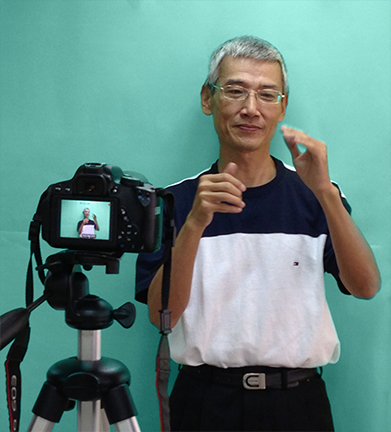Why Sign Language Bible Translations Are Essential in Reaching the Deaf

About 29 years ago, I came to know Jesus and accepted him as my Lord and Savior. Since then, I have been attending the church that I currently attend. It is an English-speaking church which has a ministry to the Deaf. At the beginning, there were only five to eight Deaf members. Today, there are about 40 of us, including those who are not highly educated.
Like the hearing members, we each own a written Bible in English. Some of us are able to read well, others can only read at a certain level, but cannot understand well the meaning of the message. Others cannot read at all. Those who need help have asked me to read selected Bible verses and sign to them. On Sundays, sermons are interpreted into sign language. Even with that, they still ask me to explain what the message is about. It has been a struggle since the beginning.
This is a common difficulty faced in churches with Deaf ministries in my country. When I first started attending church, I would never have thought it would be nice to own a Bible in sign language, my own heart language. A few years ago, I happened to watch a DVD containing New Testament passages in American Sign Language, yet I did not take it to heart. Some time in 2011, I was asked to assist one translation consultant in a sign language Bible translation workshop in a Southeast Asian country. Through the workshop, I came to understand the importance of a sign language Bible translation project for every Deaf community in the Asia-Pacific area.
 At the same time, the need to own a Bible in sign language, our heart language, was so urgent that we, the project team, decided to set up a translation project in our home country. Currently, we are working on translating the first set of Chronological Bible Stories (CBS) “Know God How,” and hoping to move on to do the second and third sets (“Follow God How” and “Serve God How”). After the completion of CBS, we plan to work on a full Bible text translation. We know it is a long term project with many challenges, but with God’s grace, we believe we will produce a Bible in our very own heart language.
At the same time, the need to own a Bible in sign language, our heart language, was so urgent that we, the project team, decided to set up a translation project in our home country. Currently, we are working on translating the first set of Chronological Bible Stories (CBS) “Know God How,” and hoping to move on to do the second and third sets (“Follow God How” and “Serve God How”). After the completion of CBS, we plan to work on a full Bible text translation. We know it is a long term project with many challenges, but with God’s grace, we believe we will produce a Bible in our very own heart language.
I believe that there is a similar urgency for every country in the Asia-Pacific area. At present, a few countries have set up sign language Bible translation projects. Some of the groups are translating CBS while others are working on verse-by-verse translations. One of them is working on sign language pictorial Bible stories. In many Asian countries, both Deaf and hearing people are still not aware of the importance of sign language Bible translations. The Deaf who understand its importance are not able to set up a project due to several factors. One major difficulty we have faced is the lack of funding. Many Deaf are either workers with low wages or unemployed. They are not able to contribute money. In addition, we face the lack of public understanding and support. The public, especially hearing people, do not understand why Deaf people need a Bible in sign language. People who were born Deaf or became Deaf at a very young age have been learning language via a visual mode. They struggle to learn any spoken or written language which depends heavily on audibility.
There are several reasons for the importance of having a sign language Bible translation project in every country. First, it is often misunderstood that sign language is universal. Actually, sign language is not universal. For example, the sign “father” in American Sign Language may be understood as “chicken” in Korean Sign Language or “very-big” in Myanmar Sign Language. “Woman” in Japanese Sign Language has the same handshape as “bad” in Malaysian Sign Language. Nevertheless, with simple basic gestures, I can communicate with Deaf from other countries at a superficial level, not deep conversation topics. Recalling a meeting I had attended in Japan, I was at a loss and needed an interpreter. Therefore, a Bible in sign language produced in one country can only be fully and easily understood and well-comprehended by Deaf in that country alone.
Second, a Sign Language Bible produced in one country can promote a sense of belonging and independence among Deaf Christians. When the Deaf have their own Bible in their heart language, they can “read” (watch) it daily by themselves and understand it. They do not need to wait for other people to explain or interpret for them. They can also have their own Bible study classes without having to depend on hearing people. I remember, once in a Bible class, John (pseudonym), a member of the Deaf ministry at church, expressed, “Why does a hearing person always lead the Bible class? I wish I could lead the Bible class but I am illiterate. There is nothing I can do.” When given responsibility to lead a prayer, Mary (pseudonym), another Deaf member, would express, “Not me. Not me. I don’t know how to pray. I don’t understand these words of prayer.” I believe with the Bible in sign language, the Deaf will be able to learn God’s Word, grow in their biblical knowledge, and lead study groups without depending on hearing people. Deaf will learn that the Holy Bible is for everyone, not just the hearing.
Third, many Deaf in the Asia-Pacific countries have yet to know Jesus and believe in Him. Both hearing and the Deaf can work together in evangelism but the Deaf need to take responsibility because the Deaf have some advantages in reaching out to other Deaf. We, Deaf, understand each other because we use sign language to communicate and it is easier for us to share the Good News in sign language among the Deaf communities. A friend, Matthew (pseudonym), questioned his own ability to share the gospel, “I am not sure if I can share the Good News with Deaf lost souls. I don’t know how to read Bible verses. How can I explain it to others?” Mark (pseudonym), has also expressed, “I have a hard time understanding Bible verses in English. Even if I give these printed tracts to other Deaf, they won’t read these tracts.” It is important that Deaf can study the Bible in sign language and comprehend the message, then they will be able to share with others. They will grow in the knowledge of God and will eventually be able to lead, and become pastors or evangelists to take the gospel to the Deaf communities.
 Fourth, a Sign Language Bible produced in one country will demonstrate that the sign language used in that country is a true language for the Deaf. It has its own language structure and grammar. A Bible in sign language, I believe, will prove that God’s Word is able to be shared in sign languages, not just in spoken and written languages. In the past, like other Deaf, I used to think sign language was broken English because I thought sign language we used daily was based on English, but did not follow English structure and grammar. In addition, Deaf as well as hearing tend to assume that sign language is just for daily communication. Only later in life, I learned that sign language is a true language with its distinct linguistic system. It has the same kind of expressive power as a spoken language. I believe that the availability of sign language Bibles in different media applications and modern technology will prove that sign languages used by the Deaf communities are true languages. They are not based on any spoken or written languages. Hearing people will learn and accept sign languages as true languages for the Deaf. I hope one day all Deaf will express what Mariam (pseudonym) did, “Great! Now I can understand what God says spiritually. Sign language helps me a lot in understanding spiritual things.”
Fourth, a Sign Language Bible produced in one country will demonstrate that the sign language used in that country is a true language for the Deaf. It has its own language structure and grammar. A Bible in sign language, I believe, will prove that God’s Word is able to be shared in sign languages, not just in spoken and written languages. In the past, like other Deaf, I used to think sign language was broken English because I thought sign language we used daily was based on English, but did not follow English structure and grammar. In addition, Deaf as well as hearing tend to assume that sign language is just for daily communication. Only later in life, I learned that sign language is a true language with its distinct linguistic system. It has the same kind of expressive power as a spoken language. I believe that the availability of sign language Bibles in different media applications and modern technology will prove that sign languages used by the Deaf communities are true languages. They are not based on any spoken or written languages. Hearing people will learn and accept sign languages as true languages for the Deaf. I hope one day all Deaf will express what Mariam (pseudonym) did, “Great! Now I can understand what God says spiritually. Sign language helps me a lot in understanding spiritual things.”
Fifth, setting up a translation project would create professional job opportunities for the Deaf. The highest level of education that most Deaf would have obtained would be the completion of secondary school or vocational school. In some countries, there is a substantial number of Deaf who have never gone to school. In general, few Deaf make it to tertiary education. So, the Deaf usually work as blue-collar workers or office assistants. However, a sign language Bible translation project team is formed of Deaf translators, Deaf videographers, Deaf video editors, Deaf artists, Deaf annotators, Deaf translation consultants, and so forth. Those jobs are semi-professional jobs. Deaf people will feel worthy of contributing their talents / skills to a huge project, which will benefit the Deaf communities and their societies at large. In some countries, community development may be needed for those Deaf adults who have never been to school or in the remote villages which do not have schools for the Deaf. Services and support such as teaching sign language and basic living skills, building schools and basic amenities, and other things help develop a community in need. It also means that providing community services will create professional job opportunities for the Deaf. In other words, setting up a sign language Bible translation project would empower Deaf people in many ways.
On behalf of APSDA (Asia Pacific Sign Language Development Association), I seek your prayer, moral and financial support in our efforts to promote sign language Bible translations in the Asia Pacific region.









comments